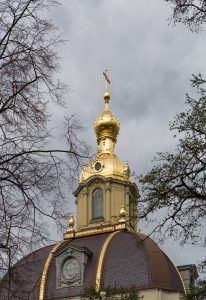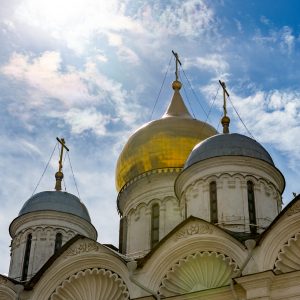93 Russian Domain: Cultural Geography – Russian Orthodox Church
The Russian Orthodox Church is a geographically and politically hierarchical Christian church with a geographic distribution of members all across Russia. As the diffusion of Christianity across space occurred historically, the closer proximity of Kiev to Constantinople (658 miles) relative to the distance from Kiev to Rome (1039 miles) simply increased the inherent probability that it would be Orthodoxy and not Catholicism that would reach Kiev. As the Russian state expanded to Moscow as the new center and to Siberia as the new periphery, the Orthodox Church came along too.
In 988, Vladimir I, ruler of Kievan Rus, officially established the Orthodox Church as the religion of the land. At that time the Church was a branch of the Eastern Orthodox Church coming out of Byzantium.
Curiously, for all of the dynamics and shifts that would come to pass in the power relationship between church and state, one of the periods of the least state control or authority over the church came during the Mongol conquest. While the Mongols exerted territorial control, they expressed very little interest in the religious life of Russia, though of course the Mongols themselves were not Orthodox.
As political power progressively moved to Moscow, so too did the church’s authority and in 1325 the official residence. In 1448 the Russian Church broke from the Eastern Church, a break that was made permanent with the 1453 fall of Constantinople, the center of Orthodoxy.
Moscow became the “Third Rome,” a separate holder of religious truth and authority. Within Russia, however, the Orthodox Church’s degree of authority vacillated, depending on the attitude of the political elite – first the attitude of the tsars, later that of the communist party, and now mainly that of Vladimir Putin.
For instance, when Patriarch Nikon sought to reform the Orthodox Church in the 17th century, he also endeavored to place the church’s authority over that of the state. His church reforms held, but his political moves failed and led to him being deposed in 1666.

Tsar Peter the Great during his reign (1682-1725) eliminated the Patriarchate and established a political link to the church that required his own authorization for church decisions. Though monasticism is a key element of the Orthodox tradition, Peter established an age limit of 50 as the minimum age for men to join monastic orders, thereby sharply reducing the number of new monks (but keeping the supply of potential soldiers high).
Unusual and charismatic religious figures have appeared in Russia, though perhaps none more noteworthy or curious than Grigori Rasputin, the mad monk. Under the last tsar, Rasputin earned the favor of the royal court by apparently healing the tsar’s son Alexis of hemophilia. Eventually Rasputin’s wild debauched behavior and growing influence prompted a group of Russian nobles to kill him. Rasputin’s legendary position gained fame when these nobles seemingly had to kill him over and over, before he actually did die. A somewhat glossy dramatization of his role appeared in Netflix’s 2019 six-part series “The Last of the Czars.”
Whatever the exact relationship between Tsar and Orthodox Church, there was a relationship and an understanding that the Russian Orthodox Church was the faith of the state and of the people. This ended with the Bolshevik Revolution, when the new communist government instituted a policy of separation of church and state.

Photo by Joel Weigand
Under communism, this separation was neither benign nor passive. In fact, the Soviet government pursued a policy of atheism, tolerating a minimum of religious faith, though what existed was very dominantly Russian Orthodoxy. Soviet authorities closed thousands of churches, turning them into neutral facilities such as warehouses or into facilities wholly inappropriate for holy buildings – into swimming pools or even into museums of atheism. Many churches simply were demolished. Soviet officials imprisoned and killed both priests and believers. At least 200,000 died specifically for their religious beliefs, reminiscent of the early Christian martyrs, though truly in much higher numbers in Russia than in other historical or geographic settings. In addition to this deadly tactic, the Soviet infiltration of the priesthood, making some priests into spies and informants for the state, was an approach that perhaps was more insidious than martyrdom.
A major policy shift occurred during World War II. In dire need to popular support for the war effort, Stalin appealed to nationalism and love of the homeland. Understanding love for the church as an aspect of love of the country, Stalin greatly relaxed government pressures on the church. In fact, some 25,000 churches were allowed to open and hold services. This open policy was reversed in the subsequent Khrushchev era.
Upon the end of communism, the Russian Orthodox Church was thrust into a new position. Gone was the oppression of state atheism. A strong majority of the roughly 150 million citizens of Russia are Russians, and thus, intrinsically belong to Russian Orthodox Church. No longer subject to the dictates of the Tsar or of communism, the faithful now can worship in peace. However, seventy years of Soviet atheism left its mark; at the breakup of the Soviet Union, many Russians had no sense of connection to the renewed church.
Numerous other denominations have stepped into this religious void. In particular, missionaries from the United States have endeavored to bring non-believers to Christian faith. While meeting with some success in guiding new converts, these denominations face the hostility of both the Russian government and the Russian Orthodox Church, largely because these groups are viewed as Western interventions that hurt Russian national unity. Some religious recruiters were authentically American – Mormons riding trains with boxes of Bibles – while others had a more widespread background. Whatever their religious heritage, these missionaries entered a Russia that held a spiritual schism – a strong national heritage in the Russian Orthodox Church surrounded by a population raised in atheism and often viewing the church as traitorous or collaborative with Soviet authority. Without much difficulty, these new missionary arrivals made significant numbers of converts.
This success, done predominantly by foreigners, was viewed with great trepidation by the Russian Orthodox Church. The church even categorized some incoming religious groups, such as the Mormons, as “totalitarian sects.” Similar concerns were shared by Russian politicians whose pride often was stung by the foreigners who apparently viewed Russia as needing improvement, even at this very personal level.

The national government’s response of church and state was a 1997 law restricting religion. To avoid major restrictions on their activities, these religious organizations had to show proof of their existence in Russia for the preceding fifteen years. Since that time frame included nearly a decade of the Soviet period during which foreign missionaries were completely excluded from entering the country, this restriction applied to almost all new religious efforts in Russia. A few groups, such as Russian Pentecostals and Baptists, could pass this test. Over two thousand religious groups were dissolved. The 1997 law was followed in 2006 by new legislation addressing the roles of non-governmental organizations (NGOs), including foreign religious missions. In the 2012 national presidential election, the Russian Orthodox Church’s Patriarch Kirill endorsed Vladimir Putin.
Conventionally obscure and cultish is the following of Sergei Torop, known as “Jesus of Siberia.” Formerly a factory worker and traffic cop in the Krasnodar region, Torop returned to the Siberia of his youth, having experienced a religious awakening in the new Russia. Now with over four thousand followers in the Church of the Last Testament and set in the wilds of Siberia, he also is known as “Vissarion Jesus” to his flock and is viewed by outsiders as a charlatan and brainwasher. VICE did a video report on him – https://www.youtube.com/watch?v=W2Cv5hZfOmk
Did You Know?
Traditionally, Russian Orthodox churches have no pews or chairs. Worshippers stand for the services.
A schism in the 17th century divided Russian believers. A minority of believers rejected Patriarch Nikon’s reforms, including a dispute on the issue of how many fingers should be used to make the sign of the cross (old way – two fingers, new way – three fingers). The so-called “Old Believers” preserved the historic rituals; the group remains a small minority on Russia’s current religious landscape.
The Russian Orthodox Church is famous for its iconography. Many individual believers own icons, holy images painted usually on wood and done in a format and style approved by the Church. In the Russian language, creators of an icon (or other advanced art) are said to write the icon.
In January 2019, as a result of Russia’s war with Ukraine, a new Ukrainian Orthodox Church officially broke away from the larger Russian Orthodox Church.
Hot Off the Press
Now in September 2020, Russian authorities arrested Sergei Torop, aka Vissarion Jesus. https://www.theguardian.com/world/2020/sep/22/cult-leader-vissarion-reincarnation-jesus-arrested-siberia-russia
An update on this situation is found in the October 24, 2021, New York Times article. https://www.nytimes.com/2021/10/24/world/europe/russia-church-repression-siberia.html
Cited and additional bibliography:
Kozyrev, Yuri. 2019. “Vissarion, Jesus of Siberia.” NOOR. February 22, 2019. https://www.noorimages.com/newsroom/2019/3/4/vissarion-jesus-of-siberia.
Satter, David. 2012. “Russia’s State Church – Foreign Policy Research Institute.” Https://Www.Fpri.Org/. June 27, 2012. https://www.fpri.org/article/2012/06/russias-state-church/.
VICE. 2012. “Siberian Cult Leader Thinks He’s Jesus.” YouTube. https://www.youtube.com/watch?v=W2Cv5hZfOmk.


